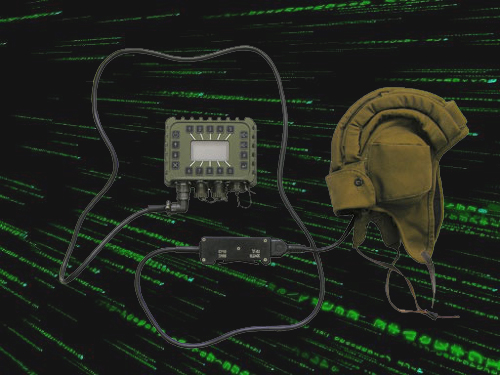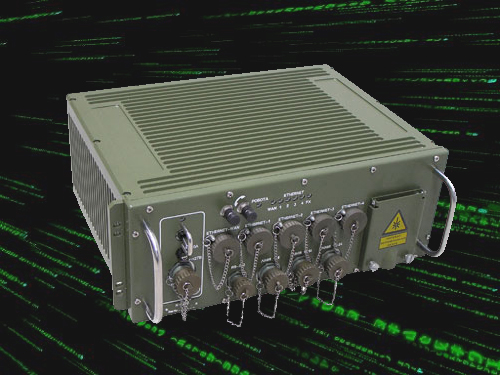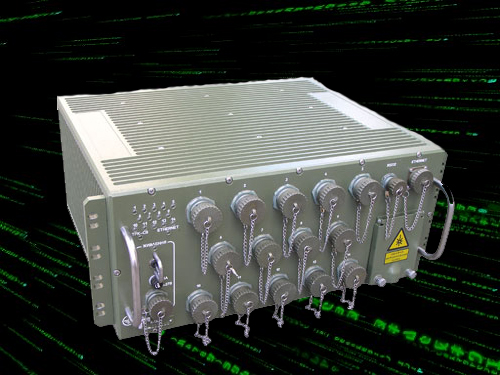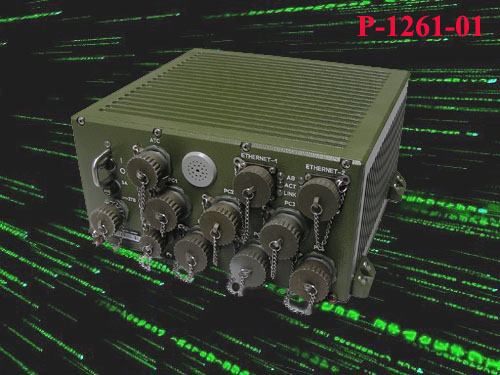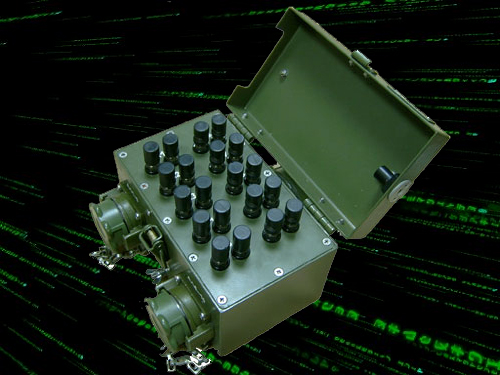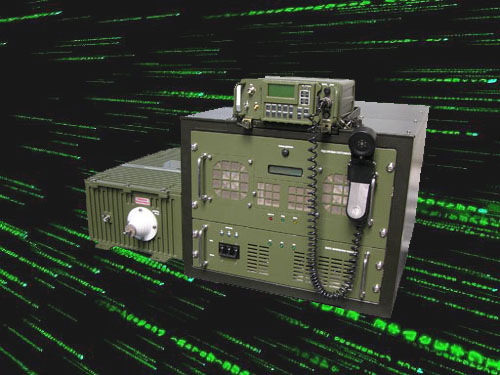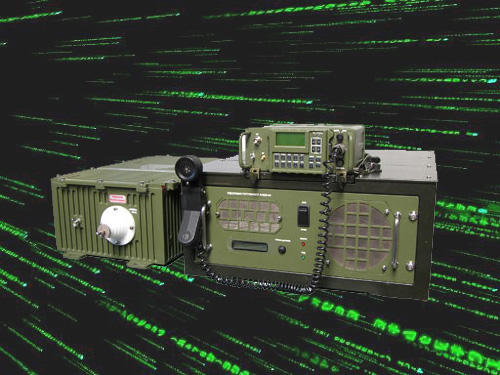- Details
UCD terminal (User Control Device) enables users to access communication services within their own vehicle, or in vehicles to which they are networked.
The terminal can be used in environmental characteristics:
- ambient temperature from - 35 º to + 50 º C
- relative humidity of not more than 98% at 25 º C
- ambient pressure of 60 kPa to 113 kPa .
Technical specifications:
Types of communication:
- the inner-sided telephone
- external bilateral telephone on any of the stations
- external bilateral telephone on any of the telephone lines
Management:
- management of the terminal is held on the front panel.
- control and adjustment may carried out by a computer via RS-232 or network Ethernet 10/100 BASE-T.
Power is carried out by a direct current voltage of 18-36 V with protection against wrong polarity changes.
Dimensions (w, g, h): 172x124x55mm.
- Details
VoIP Gateway K-1220 is designed to provide voice data for IP-data networks.
The gateway can be used in climatic conditions:
- ambient temperature from 238 to 323 K (from - 35 º to + 50 º C)
- relative humidity of not more than 98 % at 298 K (25 º C)
- atmospheric pressure of 60 kPa to 113 kPa.
The weight of the gateway - no more than 18 kg
Dimensions:
- Lengh - 490 mm;
- Width - 490 mm;
- Height - 300 mm
Technical specifications:
Gateway provides connectivity:
- 20 analog phones for two-wire subscriber lines (lines FXS);
- four-wire analog connection lines to connect to a private automatic branch exchange (PBX) (Line FXO);
- five devices enabled for Ethernet 10Base-T/100Base-TX;
- a device that supports the technology, Ethernet 100Base-FX;
- a personal computer (PC) through the RS-232
- an analog service with the TA local battery.
For the analog subscriber lines Gateway provides:
- the ability to install a voice connection with any local subscribers of the gateway and remote subscribers from other gateways
- reception rooms in the momentum and in the tone (DTMF) set
- the generation of tone for FXS lines and detection tone for lines FXO;
- the call forwarding service
- transfer of facsimile (fax transmission protocol is supported through VOIP - T. 38).
Gateway supports the following voice codecs:
- G.711 (A-Law, u-Law);
- G.723.1;
- G.729 a / b.
To improve the quality of the voice gateway uses algorithms for echo cancellation G.165 / G. 168.
For correct transmission of DTMF tones on IP-networks gateway supports the protocol RFC2833.
To establish a VoIP-connections on IP-networks, the gateway supports the following signaling protocols:
- ITU-T H.323 version 4 (read more - H.323);
- SIP RFC3261 2.0 (more - SIP).
Gateway has the opportunity to work as a central device for interoperability of other VoIP-devices (terminals , gateways, telephones, VOIP). This gateway supports the following protocols:
- H.323 Gatekeeper;
- SIP Proxy with the function of the Registrar (read more - SIP Proxy / registrar).
To allow for flexible adjustment of the registration plan gateway supports the numbering system E.164 public networks.
Power sypply:
- DC 27 V with a limit deviation of voltage from 18 to 36 V.
- Details
Path Switching and Multiplexing Equipment К – 1301 (PSME) is designed to provide operational switching and multiplexing (demultiplexing) multi-speed paths in integrated communications hardware for various purposes.
PSME operates in the following climatic conditions:
- temperature of ambient environment is in the range from 243 to 323K (from -300 to +500 C)
- relative humidity is not more than 98% under the temperature of 298K (250 C)
- air pressure is from 60 кPa to 113 кPа (from 450 to 850 mm.m.c).
PSME weight is not more 45 kg
Dimensions:
- Length – 460 mm;
- Width – 555 mm;
- Height – 240 mm
Specifications
-
PSME provides connection and processing up to 48 grouped flows with transfer rate up to 2048 kbps or 12 grouped flows with transfer rate 8448 kbps each according to ITU-Т G.703 и ITU-Т G.704 international recommendations in АМІ codes (only for 2048 kbps) or HDB 3.
- PSME has two grouped fiber-optic paths.
-
PSME performs crossing of grouped flows with each other and converting of their electrical parameters according to the standards, which are used, while working with the same rate.
-
PSME has the possibility to multiplex any four Е1paths with the rates 2048 kbps in one Е2 path with the rate 8448 kbps.
- PSME has the possibility to demultiplex any Е2 path with the rate 8448 kbps into four Е1paths with the rate 2048 kbps.
-
The possibility to enclosure loops of digital flows to the side of channel-forming hardware and to the side of home equipment is implemented in PSME.
Mean-time-between-failures is not less 5000 hours.
Power supply:
DC: 27 V with extreme voltage deviation from 18 to 36V.
- Details
Radio Gateway R-1261 is designed to provide interface between radio nets, digital automatic communication switchboard systems (DACSs) and LANs in stationary and combat communication systems; information exchange between counterpartners of radio nets and telephone users, as well as users of automated control systems.
R- 1261 operates in the following climatic conditions:
- temperature of ambient environment is in the range from 238 to 323K (from -350 to +500 C)
- relative humidity is not more than 98% under the temperature of 298K (250 C)
- air pressure is from 60 кPa to 113 кPа (from 450 to 850 mm.m.c).
Weight is not more 25 kg
Dimensions:
- Length – 490 mm;
- Width – 490 mm;
- Height – 300 mm.
Specifications
Radio Gateway R-1261 provides connection of:
- six VHF and HF tactical radios in simplex, half-duplex and duplex modes;
- six analog telephones;
- digital telephone set (ISDN BRI channel);
- PC at RS-232-interface;
- two external LANs at Ethernet 10 Base-T-interface;
- one ISDN BRI channel;
- two analog trunks from DACS.
Radio Gateway R-1261 provides message exchange of:
- radiotelephony and data transfer between counterpartners of different radio nets;
- radiotelephony between counterpartners of radio nets and analog telephone users;
- radiotelephony and data transfer between counterpartners of radio nets and digital ISDN telephone users;
- radiotelephony and data transfer between counterpartners of radio nets and terminal equipment (digital telephone set and PC), connected directly to the radio gateway.
Radio Gateway R-1261 provides automatic connection and data exchange of:
- counterpartners of different radio nets with radio stations, connected to the radio gateway;
- counterpartners of radio nets with users of ATS ;
- users of ATS with counterpartners of radio nets;
- counterpartners of radio nets with users of LAN workstations;
- users of LAN workstations with counterpartners of radio nets;
- counterpartners of radio nets with radio gateway operator;
- radio gateway operator with counterpartners of radio nets;
- users of ATS (analog and ISDN) with radio gateway operator;
- radio gateway operator with users of ATS (analog and ISDN);
- radio gateway operator with users of LAN workstations;
- users of LAN workstations with radio gateway operator.
Power supply:
Power supplying is provided by direct current 27 V with extreme voltage deviation from 18 to 36V.
- Details
Army Cross-Connecting Module КР-351 is designed to provide line connection of user’s data terminal equipment of different kinds of communication (telephony, telegraphy, etc.) in stationary and field communication systems, which are pars of user networks of automatic and manual switching system.
Army Cross-Connecting Module operates in the following climatic conditions:
- temperature of ambient environment is in the range from 238 to 323K (from -350 to +500 C)
- relative humidity is not more than 98% under the temperature of 298K (250 C)
- air pressure is from 60 кPa to 113 кPа (from 450 to 850 mm.m.c).
Army Cross-Connecting Module weight is not more 3,0 kg
Dimensions:
- Length – 200 mm;
- Width – 200 mm;
- Height – 140 mm
Specifications:
Army Cross-Connecting Module provides:
-
connection up to ten double-wire or up to five four-wire subscriber lines with P-274P cable or similar to utility shed (station), using PTRK10х2 army cable;
-
transit of two groups with five double-wire lines or with two four-wire subscriber lines, each of them uses PTRK 10х2 army cable from the station side (hardware half-coupling AL1-10) and two PTRK 5х2 army cables from the subscriber side (hardware half-coupling AL1-5 and AL5-10).
There are no integral power supplies in Army Cross-Connecting Module, and it doesn’t require connection to external power supplies.
Army Cross-Connecting Module provides protection of subscriber lines (separately) against overrating voltage and overcurrents, as well as lightening discharges, which can influence their operability.
- Details
HF tactical radio R-1150-02 is designed to provide digital communication in stationary and field combat communication systems. R-1150-02 can operate in stationary signal centers and combat communication systems of different levels.
Radio P-1150-02 supports the work of the digital network technology to transmit data over IP. This allows the use of the radio channel gateway IP data transfer protocol, and thus to combine network segments into a single information space, and ensuring the delivery of data between any of the subscribers of the global network.
Specifications
- frequency range: 1,5 MHz ÷ 30 MHz;
- modes of operation: - simplex, - half-duplex, - FHSS, - ALE;
- number of programmed channels : 399;
- step of frequency setting: 10Hz;
- types of modulation: A1A, J3E, B8E, A3E, F3E (F1B in FSK –modem mode);
- interfaces: - audio (600 ohm, 0 dbm)
- data (RS-232, RS-422, RS-423)
- control (RS-232, RS-422, RS-423, RS-485and Ethernet); - output power : 1 kW;
R-1150-02 has performance check test, which starts automatically when power is on or upon operator’s command.
R-1150-02 provides the following ways of control:
- local (using control board);
- remote (from computer at RS-232, RS-422, RS-423 or RS-485 interfaces);
- remote (from computer through Ethernet).
Operations in ALE mode:
- channel scanning ;
- channel sounding;
- individual call;
- net call;
- group call;
- specific call;
- automatic display of message.
R-1150-02 provides digital data transfer with the following rates for paths’ types:
- FSK: 50, 75, 100, 150, 300, 600 bs;
- STANAG 4285 coded: 75, 150, 300, 600, 1200, 2400 bps;
- STANAG 4285 uncoded: 1200, 2400, 3600 bps;
- STANAG 4529 coded: 75, 150, 300, 600, 1200 bps;
- STANAG 4529 uncoded: 600, 1200, 1800, bps;
- STANAG 4539 coded: 75, 150, 300, 600, 1200, 2400, 3200, 4800, 6400, 8000, 9600 bps;
- STANAG 4539 uncoded: 12800 bps;
- STANAG 4415: 75 bps;
- MIL-STD-188-110B App. C coded: 3200, 4800, 6400, 8000, 9600 bps;
- MIL-STD-188-110B App. C uncoded: 12800 bps;
- MIL-STD-188-110B: 75, 150, 300, 600, 1200, 2400, 4800 bps;
- MIL-STD-188-110B App. F: 9600, 12800, 16000, 19200 bps.
R-1150-02 provides voice communication with the following parameters:
- vocoder standard: STANAG 4198;
- transfer standard: MIL-STD-188-110B App. B;
- rate : 2400 bps.
Parameters of operation in FHSS mode:
- number of frequency hops: 8,8 (8) hps;
- length of frequency hops : 112,5 m/sec;
- maximum data transfer rate: 2400 bps.
R-1150-02 operates in the following climatic conditions:
- temperature of ambient environment is in the range from 253 to 328K (from -20̊ to +55̊ C)
- relative humidity is not more than 98% under the temperature of 298K (25̊ C)
- air pressure is from 60 кPa to 113 кPа (from 450 to 850 mm.m.c).
Resistance to environmental conditions is according to group 1.8 execution UXL of the State Standard В 20.39.304-76.
Power supply:
- AC: power source - separate current conversion unit of AC 220V, 50Hz into DC 27V.
- DC: 22…30V, protected from false polarity connection. Rating value - 27 V.
R-1150-02 can interoperate with:
- STANAG 4203 HF tactical radio through radio channel;
- computers with RS-232, , RS-422, RS-423, RS-485 and Ethernet - interfaces through control circuits;
- data transfer equipment with RS-232, RS-422 и RS-423- interfaces through wire data links;
- equipment of different types through wire voice channels.
- Details
HF tactical radio R-1150-01 is designed to provide digital communication in stationary and field combat communication systems. R-1150-01 can operate in stationary signal centers and combat communication systems of different levels.
Radio P-1150-01 supports the work of the digital network technology to transmit data over IP. This allows the use of the radio channel gateway IP data transfer protocol, and thus to combine network segments into a single information space, and ensuring the delivery of data between any of the subscribers of the global network.
Specifications
- frequency range: 1,5 MHz ÷ 30 MHz;
- modes of operation: - simplex, - half-duplex, - FHSS, - ALE;
- number of programmed channels : 399;
- step of frequency setting: 10Hz;
- types of modulation: A1A, J3E, B8E, A3E, F3E (F1B in FSK –modem mode);
-
interfaces:
- - audio (600 ohm, 0 dbm)
- - data (RS-232, RS-422, RS-423)
-
- control (RS-232, RS-422, RS-423, RS-485and Ethernet);
-
output power : 400 W;
R-1150-01 has performance check test, which starts automatically when power is on or upon operator’s command.
R-1150-01 provides the following ways of control:
- local (using control board);
- remote (from computer at RS-232, RS-422, RS-423 or RS-485 interfaces);
- remote (from computer through Ethernet).
Operations in ALE mode::
- channel scanning ;
- channel sounding;
- individual call;
- net call;
- group call;
- specific call;
- automatic display of message.
R-1150-01 provides digital data transfer with the following rates for paths’ types:
- FSK: 50, 75, 100, 150, 300, 600 bs;
- STANAG 4285 coded: 75, 150, 300, 600, 1200, 2400 bps;
- STANAG 4285 uncoded: 1200, 2400, 3600 bps;
- STANAG 4529 coded: 75, 150, 300, 600, 1200 bps;
- STANAG 4529 uncoded: 600, 1200, 1800, bps;
- STANAG 4539 coded: 75, 150, 300, 600, 1200, 2400, 3200, 4800, 6400, 8000, 9600 bps;
- STANAG 4539 uncoded: 12800 bps;
- STANAG 4415: 75 bps;
- MIL-STD-188-110B App. C coded: 3200, 4800, 6400, 8000, 9600 bps;
- MIL-STD-188-110B App. C uncoded: 12800 bps;
- MIL-STD-188-110B: 75, 150, 300, 600, 1200, 2400, 4800 bps;
- MIL-STD-188-110B App. F: 9600, 12800, 16000, 19200 bps.
R-1150-01 provides voice communication with the following parameters:
- vocoder standard: STANAG 4198;
- transfer standard: MIL-STD-188-110B App. B;
- rate : 2400 bps.
Parameters of operation in FHSS mode:
- number of frequency hops: 8,8 (8) hps;
- length of frequency hops : 112,5 m/sec;
- maximum data transfer rate: 2400 bps.
R-1150-01 operates in the following climatic conditions:
- temperature of ambient environment is in the range from 253 to 328K (from -20̊ to +55̊ C)
- relative humidity is not more than 98% under the temperature of 298K (25̊ C)
- air pressure is from 60 кPa to 113 кPа (from 450 to 850 mm.m.c).
Resistance to environmental conditions is according to group 1.8 execution UXL of the State Standard В 20.39.304-76.
Power supply:
- AC: power source - separate current conversion unit of AC 220V, 50Hz into DC 27V.
- DC: 22…30V, protected from false polarity connection. Rating value - 27 V.
R-1150-01 can interoperate with:
- STANAG 4203 HF tactical radio through radio channel;
- computers with RS-232, , RS-422, RS-423, RS-485 and Ethernet - interfaces through control circuits;
- data transfer equipment with RS-232, RS-422 и RS-423- interfaces through wire data links;
-
equipment of different types through wire voice channels.
- Details
HF tactical radio R-1150 is designed to provide digital communication in stationary and field combat communication systems. R-1150 can operate in stationary signal centers and combat communication systems of different levels.
Radio P-1150 supports the work of the digital network technology to transmit data over IP. This allows the use of the radio channel gateway IP data transfer protocol, and thus to combine network segments into a single information space, and ensuring the delivery of data between any of the subscribers of the global network.
In the basic configuration is completed amplifier at 150 watts. Depending on customer requirements can be completed amps at 400 W and 1 kW.
Specifications
- frequency range: 1,5 MHz ÷ 30 MHz;
- modes of operation: - simplex, - half-duplex, - FHSS, - ALE;
- number of programmed channels : 399;
- step of frequency setting: 10Hz;
- types of modulation: A1A, J3E, B8E, A3E, F3E (F1B in FSK –modem mode);
-
interfaces:
- - audio (600 ohm, 0 dbm)
- - data (RS-232, RS-422, RS-423)
-
- control (RS-232, RS-422, RS-423, RS-485and Ethernet);
-
output power : (150±30) W; option 400 W & 1 KW
R-1150 has performance check test, which starts automatically when power is on or upon operator’s command.
R-1150 provides the following ways of control:
- local (using control board);
- remote (from computer at RS-232, RS-422, RS-423 or RS-485 interfaces);
- remote (from computer through Ethernet).
Operations in ALE mode::
- channel scanning ;
- channel sounding;
- individual call;
- net call;
- group call;
- specific call;
- automatic display of message.
R-1150 provides digital data transfer with the following rates for paths’ types:
- FSK: 50, 75, 100, 150, 300, 600 bs;
- STANAG 4285 coded: 75, 150, 300, 600, 1200, 2400 bps;
- STANAG 4285 uncoded: 1200, 2400, 3600 bps;
- STANAG 4529 coded: 75, 150, 300, 600, 1200 bps;
- STANAG 4529 uncoded: 600, 1200, 1800, bps;
- STANAG 4539 coded: 75, 150, 300, 600, 1200, 2400, 3200, 4800, 6400, 8000, 9600 bps;
- STANAG 4539 uncoded: 12800 bps;
- STANAG 4415: 75 bps;
- MIL-STD-188-110B App. C coded: 3200, 4800, 6400, 8000, 9600 bps;
- MIL-STD-188-110B App. C uncoded: 12800 bps;
- MIL-STD-188-110B: 75, 150, 300, 600, 1200, 2400, 4800 bps;
- MIL-STD-188-110B App. F: 9600, 12800, 16000, 19200 bps.
R-1150 provides voice communication with the following parameters:
- vocoder standard: STANAG 4198;
- transfer standard: MIL-STD-188-110B App. B;
- rate : 2400 bps.
Parameters of operation in FHSS mode:
- number of frequency hops: 8,8 (8) hps;
- length of frequency hops : 112,5 m/sec;
- maximum data transfer rate: 2400 bps.
R-1150 operates in the following climatic conditions:
- temperature of ambient environment is in the range from 253 to 328K (from -20̊ to +55̊ C)
- relative humidity is not more than 98% under the temperature of 298K (25̊ C)
- air pressure is from 60 кPa to 113 кPа (from 450 to 850 mm.m.c).
Resistance to environmental conditions is according to group 1.8 execution UXL of the State Standard В 20.39.304-76.
Power supply:
- AC: power source - separate current conversion unit of AC 220V, 50Hz into DC 27V.
- DC: 22…30V, protected from false polarity connection. Rating value - 27 V.
R-1150 can interoperate with:
- STANAG 4203 HF tactical radio through radio channel;
- computers with RS-232, , RS-422, RS-423, RS-485 and Ethernet - interfaces through control circuits;
- data transfer equipment with RS-232, RS-422 и RS-423- interfaces through wire data links;
-
equipment of different types through wire voice channels.
- Details
Mobile 30W VHF tactical radio R-030U is designed to provide radio communication, used at army tanks, armored personnel carriers, wheeled and tracked fighting vehicles. R-030U provides the possibility to transmit and receive voice information and digital data while operating on fixed frequencies (interference mode) and in anti-interference mode. Protection from jamming is done using Frequency-Hopping-Spread-Spectrum (FHSS) mode. Frequency tuning rate is 312, 5 times per sec.
The radio station P-030U has a modification which provides work in digital networks with the technology of data transmission over IP. This allows the use of the radio channel gateway IP data transfer protocol, and thus to combine network segments into a single information space, and ensuring the delivery of data between any of the subscribers of the global network.
The R-030U tactical radio can be set without structural revisions on all types of armor vehicles for replacement of old park stations (Р-123 or Р-173).
R- 030U operates in the following modes:
- simplex; - half-duplex;-standby reception ; - single-frequency simplex (half-duplex) in one radio net and standby reception in another;- entering of radio data; - retransmission.
While on fixed frequencies and FHSS mode, R- 030U provides transmission and reception of:
- voice information from handset or telephone headset ;
- voice information from laryngophone-telephone headset (intercom);
- analog information in the frequency range from 300 to 3400 Hz at С1-ТЧ-interface ;
- digital data with rate: 1200, 2400, 4800, 9600, 16000 bps from PC or other devices at RS – 232 interface;
- digital data with rate: 1200, 2400, 4800, 9600, 16000 bps from devices at C-1 I- interface;
- short alphanumeric messages;
- individual (selective), circular (group) and tone calls.
While operating on fixed frequencies, voice information is transmitted in:
-
analog form in F3 emission class, which provides connection of radio station through radio channel with radio stations of other types, older ones in particular;
-
digital form in F1 emission class. Voice analog information is converted into digital form by embedded CVSD-delta codec. Conversion rate of voice information is 16000bps.
In FHSS mode voice information is transmitted only with conversion into digital form (CVSD) in F1 emission class.
Voice information, converted into digital form, can be transmitted with technical masking or without it. Technical masking is provided by voice masking devise, which is embedded in radio.
R- 030U provides radio coverage on medium-cross country while the facility, equipped with radio, stands or in movement, working on rod circular-pattern antenna with the range of 20 - 30 km.
R- 030U can operate on not more than 16 preprogrammed channels on fixed frequencies (from 1 to 16), and on not more than 16 preprogrammed channels in FHSS mode (from 17 to 32). The selection of programmed channel is done, using the buttons on the front panel of the radio, remote-control and PC.
While working with R- 030U, it possible to control it and enter radio data from:
- Control panel;
- Remote-control ;
- PC;
- storage and radio data input device.
R- 030U software specifies the procedure of channel programming. While radio station is programming, the following radio data should be entered:
- operating frequency;
- type of information (voice or data transmission);
- emission class;
- technical masking mode;
- level of output power;
- current time;
- type of squelcher;
- call type (individual (selective), circular (group), tone);
- called number;
- home number of radio station;
- short alphanumeric messages (30 five-symbol groups);
- passwords (programming password and operator password);
- keys ( FHSS key and masking key);
- mode of operation data.
R- 030U can be controlled from:
- the keyboard on the front panel of the transceiver;
- PC (using the “Commander”, which rules on how to use it are in operator’s manual)
- Remote control unit.
Power supply
- embedded network of vehicles with grounded “minus”: 27 V.
- accumulator: 18…34V.
Performance control of embedded network is done by built-in control system. The results are displayed on the R- 030U control panel. R- 030U provides twenty-four-hour operation without forced cooling in relation reception /transmission as 9:1; average time of incessant transmission is not less 3min.
R- 030U operates in the following climatic conditions:
- temperature of ambient environment is in the range from 238 to 328K (from -35 C to +55 C)
- relative humidity is not more than 98% under the temperature of 298K (25 C)
- air pressure is from 60 кPa to 113 кPа (from 450 to 850 mm.m.c).
Dimensions:
- Length – 427 mm;
- Width – 222 mm;
- Height – 178 mm.
Specifications
- Frequency range: 30 … 110 MHz;
- Nominal output power: 30W; - low output power: 1,0 W.
- Embedded control performance system, which detects bad element accurate within plug-in card.
Operation life is not less 20 years.



